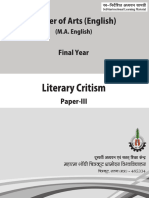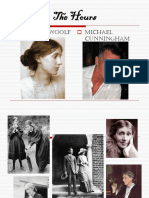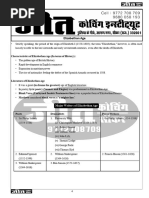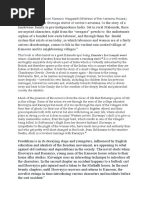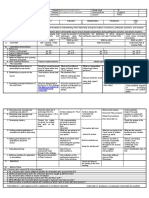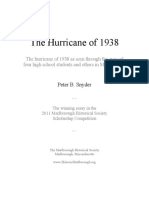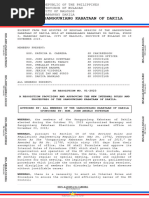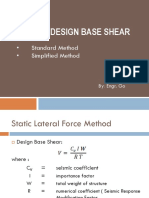100%(1)100% found this document useful (1 vote)
206 viewsMy Life Had Stood
My Life Had Stood
Uploaded by
Laura UngureanuEmily Dickinson was a famous American poet born in Amherst, Massachusetts to a prominent family. She often included poems in her letters to friends and was encouraged by them to publish, though she only attempted publication once in 1860. The poem "My Life Had Stood - a Loaded Gun" represents Dickinson characterizing her immense poetic abilities in the most extreme way, speaking through the voice of a gun to present herself as the opposite of what a woman was considered to be in her time: cruel rather than pleasant, hard rather than soft, and one who kills rather than nurtures. The poem compares her smile to the aftermath of a volcanic eruption, signaling completed violence rather than present intimacy. It depicts Dickinson
Copyright:
© All Rights Reserved
Available Formats
Download as DOC, PDF, TXT or read online from Scribd
My Life Had Stood
My Life Had Stood
Uploaded by
Laura Ungureanu100%(1)100% found this document useful (1 vote)
206 views2 pagesEmily Dickinson was a famous American poet born in Amherst, Massachusetts to a prominent family. She often included poems in her letters to friends and was encouraged by them to publish, though she only attempted publication once in 1860. The poem "My Life Had Stood - a Loaded Gun" represents Dickinson characterizing her immense poetic abilities in the most extreme way, speaking through the voice of a gun to present herself as the opposite of what a woman was considered to be in her time: cruel rather than pleasant, hard rather than soft, and one who kills rather than nurtures. The poem compares her smile to the aftermath of a volcanic eruption, signaling completed violence rather than present intimacy. It depicts Dickinson
Original Description:
My Life Had Stood
Copyright
© © All Rights Reserved
Available Formats
DOC, PDF, TXT or read online from Scribd
Share this document
Did you find this document useful?
Is this content inappropriate?
Emily Dickinson was a famous American poet born in Amherst, Massachusetts to a prominent family. She often included poems in her letters to friends and was encouraged by them to publish, though she only attempted publication once in 1860. The poem "My Life Had Stood - a Loaded Gun" represents Dickinson characterizing her immense poetic abilities in the most extreme way, speaking through the voice of a gun to present herself as the opposite of what a woman was considered to be in her time: cruel rather than pleasant, hard rather than soft, and one who kills rather than nurtures. The poem compares her smile to the aftermath of a volcanic eruption, signaling completed violence rather than present intimacy. It depicts Dickinson
Copyright:
© All Rights Reserved
Available Formats
Download as DOC, PDF, TXT or read online from Scribd
Download as doc, pdf, or txt
100%(1)100% found this document useful (1 vote)
206 views2 pagesMy Life Had Stood
My Life Had Stood
Uploaded by
Laura UngureanuEmily Dickinson was a famous American poet born in Amherst, Massachusetts to a prominent family. She often included poems in her letters to friends and was encouraged by them to publish, though she only attempted publication once in 1860. The poem "My Life Had Stood - a Loaded Gun" represents Dickinson characterizing her immense poetic abilities in the most extreme way, speaking through the voice of a gun to present herself as the opposite of what a woman was considered to be in her time: cruel rather than pleasant, hard rather than soft, and one who kills rather than nurtures. The poem compares her smile to the aftermath of a volcanic eruption, signaling completed violence rather than present intimacy. It depicts Dickinson
Copyright:
© All Rights Reserved
Available Formats
Download as DOC, PDF, TXT or read online from Scribd
Download as doc, pdf, or txt
You are on page 1of 2
My Life Had Stood a Loaded Gun
Emily Dickinson, one of Americas famous poets, was born in
Amherst to a prominent family. She often included poetry with her letters
to friends. Her friends encouraged her to publish, but after an attempt to
do so in 1860, Emily did not appear to try again.
Composed during the period when Dickinson had reached the
height of her poetic prowess, My Life Had Stood represents the poets
most extreme attempt to characterize the Vesuvian nature of the power
or art which she believed was hers. Speaking through the voice of gun,
Dickinson presents herself in this poem as everything woman is not :
cruel not pleasant, hard not soft, emphatic not weak, one who kills not
one who nurtures.
In the first instance, the speaker/ Gun compares her smile to the
aftermath of a volcanic eruption. Her smile is not like the volcanos fire or
threat but like its completed act: when she smiles it is as if a volcano had
erupted. The past perfect verb is more chilling than the present tense
would be because it signals completion, even in the midst of a
speculative (as if) comparison; her smile has the cordiality of ash,of
accomplished violence or death, not just of present.Both uses of the
perfect tense in this poem distance the speaker from humanity, perhaps
as any skewed analogy would. Yet by allying herself with catastrophic
power rather than sexual intimacy, she may also be indicating that the
former seems more possible or safer to her; even the power of
volcanoes may be known. The change in tense alerts the reader to the
peculiarity and importance of the comparisons.
Here the poet sees herself as split, not between anything so simple
as masculine and feminine identify but between the hunter, admittedly
masculine, but also a human person, an active, willing being, and the
gunan object, condemned to remain inactive until the hunterthe
ownerstakes possession of it.
In the psychological context of this archetypal struggle Emily
Dickinson joins in the killing of the doe without a murmur of pity or regret;
she wants the independence of will and the power of mind which her
allegiance with the woodsman makes possible. Specifically, engagement
with the animus unlocks her artistic creativity; through his inspiration and
mastery she becomes a poet
To begin with, for a woman like Dickinson, choosing to be an artist
could seem to require denying essential aspects of herself and
relinquishing experience as lover, wife and mother. From other poems we
know Dickinsons painfully, sometimes excruciatingly divided attitude
toward her womanhood, but here under the spell of the animus muse
she does not waver in the sacrifice.
You might also like
- My Life Had Stood - A Loaded GunDocument6 pagesMy Life Had Stood - A Loaded GunTako ChanNo ratings yet
- Critical TheoryDocument96 pagesCritical TheoryAsmita RaiNo ratings yet
- Why The Novel MattersDocument2 pagesWhy The Novel MattersTasnim Azam MoumiNo ratings yet
- Sonnet 18Document15 pagesSonnet 18albertherrera540No ratings yet
- Elizabethan PoetryDocument2 pagesElizabethan Poetrymughalhafeez443No ratings yet
- The Last Ride Together Poem Critical AnalysisDocument7 pagesThe Last Ride Together Poem Critical AnalysisBookbloggishNo ratings yet
- Preface To Lyrical Ballads - OutlineDocument2 pagesPreface To Lyrical Ballads - Outlinecgh3_1415No ratings yet
- Chief Characteristics of Dryden As A CriticDocument4 pagesChief Characteristics of Dryden As A CriticQamar KhokharNo ratings yet
- Dramatic PoessyDocument4 pagesDramatic PoessyRatheesh SomanathanNo ratings yet
- Preface To Lyrical BalladsDocument4 pagesPreface To Lyrical BalladsSoundararajan RajagopalanNo ratings yet
- The Romantic Period Was Largely A Reaction Against The Ideology of The Enlightenment Period That Dominated Much of European PhilosophyDocument4 pagesThe Romantic Period Was Largely A Reaction Against The Ideology of The Enlightenment Period That Dominated Much of European PhilosophyratihNo ratings yet
- MiddlemarchDocument8 pagesMiddlemarchGheorghe AlexandraNo ratings yet
- Poem Ode To Autumn Summary Class 8Document12 pagesPoem Ode To Autumn Summary Class 8tanisha sharmaNo ratings yet
- Bright StarDocument2 pagesBright StarDaraNo ratings yet
- Our Casuarina Tree by Toru Dutt - Poem AnalysisDocument9 pagesOur Casuarina Tree by Toru Dutt - Poem AnalysisMysterious FactNo ratings yet
- Meg 01Document11 pagesMeg 01arun1974No ratings yet
- Robert BrowningDocument18 pagesRobert BrowninganithafNo ratings yet
- tmp9634 TMPDocument24 pagestmp9634 TMPFrontiersNo ratings yet
- Novel, Its Evolution and Features of Modern NovelDocument40 pagesNovel, Its Evolution and Features of Modern NovelImran AslamNo ratings yet
- The Cambridge Companion To Rabindranath Tagore (Cambridge Companions To Literature) (Sukanta Chaudhuri (Editor) )Document408 pagesThe Cambridge Companion To Rabindranath Tagore (Cambridge Companions To Literature) (Sukanta Chaudhuri (Editor) )Willer SiqueiraNo ratings yet
- II Sem English NotesDocument8 pagesII Sem English NotesAbishek RajuNo ratings yet
- Elements of Exile and Alienation in R. Parthasarathy's Poem: 'Trial'Document8 pagesElements of Exile and Alienation in R. Parthasarathy's Poem: 'Trial'anjuNo ratings yet
- Enterprise by Nissim EzekielDocument5 pagesEnterprise by Nissim EzekielAarti VasanNo ratings yet
- A.K. Ramanujan - Love Poem For A Wife, 1Document3 pagesA.K. Ramanujan - Love Poem For A Wife, 1Sajal ArifNo ratings yet
- 39-48 Dr. BASAVARAJ TALLURDocument10 pages39-48 Dr. BASAVARAJ TALLURdrsubramanianNo ratings yet
- The Hours: Virginia Woolf Michael CunninghamDocument28 pagesThe Hours: Virginia Woolf Michael CunninghamPop MariaNo ratings yet
- Robert BrowningDocument5 pagesRobert Browningdy_princess91No ratings yet
- " Thou Hast Made Me, and Shall Thy Work Decay?Document2 pages" Thou Hast Made Me, and Shall Thy Work Decay?Sbgacc SojitraNo ratings yet
- The Dream ChildrenDocument10 pagesThe Dream ChildrenAditya SonuNo ratings yet
- American Literature ReviewerDocument14 pagesAmerican Literature ReviewermarlogovinaNo ratings yet
- Robert BrowningDocument4 pagesRobert BrowningDimple PuriNo ratings yet
- John DonneDocument5 pagesJohn Donneabc defNo ratings yet
- Sad Strains of A Gay WaltzDocument4 pagesSad Strains of A Gay WaltzmindlessarienNo ratings yet
- 14 Thomas-Gray-Extra-NotesDocument3 pages14 Thomas-Gray-Extra-NotesRosemary Dawn FegideroNo ratings yet
- English Tintern AbbeyDocument29 pagesEnglish Tintern AbbeyJagruti Nirav100% (1)
- HopkinsDocument9 pagesHopkinssazzad hossainNo ratings yet
- Alexander PopeDocument2 pagesAlexander Popenatura200No ratings yet
- Indianness in Nissim EzekielDocument3 pagesIndianness in Nissim EzekielAniket BobdeNo ratings yet
- Elizabethan AgeDocument3 pagesElizabethan AgechoudharyekkiNo ratings yet
- Night of The Scorpion and Prayer PoemsDocument6 pagesNight of The Scorpion and Prayer PoemsYesha ShahNo ratings yet
- Chapter Wise Summary of The OutsiderDocument19 pagesChapter Wise Summary of The Outsideriqra khalid100% (1)
- Elizabethan SonnetsDocument5 pagesElizabethan Sonnetsrngband11No ratings yet
- John Ruskin - (1865) Sesame and LiliesDocument99 pagesJohn Ruskin - (1865) Sesame and LiliesnyktheusNo ratings yet
- Sir Philip Sidney Enotes Summary of Sidney's Defence or Apology For PoetryDocument4 pagesSir Philip Sidney Enotes Summary of Sidney's Defence or Apology For Poetrycjlass100% (2)
- Dse 1Document9 pagesDse 1Amit ChowhanNo ratings yet
- Bhavs's AssignmentDocument5 pagesBhavs's Assignmentdhriti ssomasundarNo ratings yet
- 18TH CenturyDocument4 pages18TH CenturyRheynhaldough Franco-Oliva Bustamante-Giolagon Jr.No ratings yet
- 20th Century Novel - Notes-2-1Document33 pages20th Century Novel - Notes-2-1Simo MijmijNo ratings yet
- 11 2 ET V1 S1 - Introduction PDFDocument12 pages11 2 ET V1 S1 - Introduction PDFshahbaz jokhioNo ratings yet
- Assignment On Adonais (Likes & Dislikes)Document4 pagesAssignment On Adonais (Likes & Dislikes)Mr Oreo100% (1)
- Ma 3Document6 pagesMa 3surendersinghmdnrNo ratings yet
- Henry Fielding's Comic Epic in Prose: A Study of Joseph Andrews in The Light of This GenreDocument3 pagesHenry Fielding's Comic Epic in Prose: A Study of Joseph Andrews in The Light of This GenreAli AL MalkyNo ratings yet
- To His Coy Mistress Written by Kakoli Sengupta 2020Document7 pagesTo His Coy Mistress Written by Kakoli Sengupta 2020Kakoli Sen GuptaNo ratings yet
- Four Kinds of Meaning by RichardsDocument2 pagesFour Kinds of Meaning by RichardsmalagichetanmNo ratings yet
- Literary Criticism - PlatoDocument4 pagesLiterary Criticism - Platoahmedjjjkk75No ratings yet
- The Criticism of Nissim EzekielDocument6 pagesThe Criticism of Nissim EzekielKaushik RayNo ratings yet
- Christopher Marlowe Biography: SynopsisDocument4 pagesChristopher Marlowe Biography: SynopsisAbraham MarshkeNo ratings yet
- Definition and Explanation of Adjective PhrasesDocument37 pagesDefinition and Explanation of Adjective PhrasessaminceNo ratings yet
- The Rival Ladies: "Look around the inhabited world; how few know their own good, or knowing it, pursue."From EverandThe Rival Ladies: "Look around the inhabited world; how few know their own good, or knowing it, pursue."No ratings yet
- Important Questions at Check-InDocument3 pagesImportant Questions at Check-InLaura UngureanuNo ratings yet
- Bilete Oral Bilingv Cls8 de La 1 La 24-1Document7 pagesBilete Oral Bilingv Cls8 de La 1 La 24-1Laura UngureanuNo ratings yet
- Is She? 2. ..Do You Sleep? 3. ..Do You Like Ice Cream? 4. .. Do You Do in The Evening? 5. Are They?Document12 pagesIs She? 2. ..Do You Sleep? 3. ..Do You Like Ice Cream? 4. .. Do You Do in The Evening? 5. Are They?Laura Ungureanu0% (1)
- Think of The Multiple Meanings of The Following Words and Write Them DownDocument3 pagesThink of The Multiple Meanings of The Following Words and Write Them DownLaura UngureanuNo ratings yet
- Active To PassiveDocument1 pageActive To PassiveLaura UngureanuNo ratings yet
- Mixed TensesDocument1 pageMixed TensesLaura UngureanuNo ratings yet
- Put Since and For in The Following SentencesDocument2 pagesPut Since and For in The Following SentencesLaura UngureanuNo ratings yet
- List of English Irregular VerbsDocument12 pagesList of English Irregular VerbsLaura UngureanuNo ratings yet
- RevisionDocument2 pagesRevisionLaura Ungureanu0% (1)
- Did Robin Hood Really ExistsDocument2 pagesDid Robin Hood Really ExistsLaura UngureanuNo ratings yet
- PrepositionDocument1 pagePrepositionLaura UngureanuNo ratings yet
- Questions Consumerism and GlobalizationDocument4 pagesQuestions Consumerism and GlobalizationLaura UngureanuNo ratings yet
- How Positive Thinking Builds Your Skills, Boosts Your Health, and Improves Your WorkDocument6 pagesHow Positive Thinking Builds Your Skills, Boosts Your Health, and Improves Your WorkLaura UngureanuNo ratings yet
- LF598147 - GKulang Book Final Aproved For PrintingDocument256 pagesLF598147 - GKulang Book Final Aproved For PrintingJock ChuolNo ratings yet
- Republic of The Philippines Department of Education: Division of Surigao Del SurDocument10 pagesRepublic of The Philippines Department of Education: Division of Surigao Del SurVian MaderaNo ratings yet
- Contoh Explanation Text Beserta Generic Structure Dan Language FDocument3 pagesContoh Explanation Text Beserta Generic Structure Dan Language FHacker Man100% (1)
- A14 Smoke Detector Layout - GF - 3.0 TRS BalliaDocument1 pageA14 Smoke Detector Layout - GF - 3.0 TRS BalliaSuwaibah FatimaNo ratings yet
- Wen Wota Pas Gari - 1Document2 pagesWen Wota Pas Gari - 1EdwinEriataOribhaborNo ratings yet
- Railway Disaster ManagementDocument148 pagesRailway Disaster Managementpankaj.kurjiloyalaNo ratings yet
- 2014年広島豪雨災害報告書(最終版) CompressedDocument71 pages2014年広島豪雨災害報告書(最終版) CompressedNizham Izzatul IslamNo ratings yet
- G101ST QuarterDocument21 pagesG101ST QuarterEm EmNo ratings yet
- Through A Glass, Darkly: Analysis of Three Poems by W. H. AudenDocument7 pagesThrough A Glass, Darkly: Analysis of Three Poems by W. H. AudenAbigail_Robles_6169No ratings yet
- The Hurricane of 1938 As Seen Through The Eyes of Four High School Students and Others in Marlborough, MassachusettsDocument13 pagesThe Hurricane of 1938 As Seen Through The Eyes of Four High School Students and Others in Marlborough, MassachusettsLee WrightNo ratings yet
- Corporate ImageDocument86 pagesCorporate Imagesistla.suneethaNo ratings yet
- Past Simple and Past ContinuousDocument1 pagePast Simple and Past ContinuousAlejandro GómezNo ratings yet
- Wells Coppersmith 1994Document93 pagesWells Coppersmith 1994Shah FaisalNo ratings yet
- Listening Upper Level TestDocument3 pagesListening Upper Level Testalejandro.albertuzNo ratings yet
- Geophysical Investigation of Landslide Using DC-Resistivity Method: A Case Study in Cikahuripan, West BandungDocument5 pagesGeophysical Investigation of Landslide Using DC-Resistivity Method: A Case Study in Cikahuripan, West BandungIlyas AryaNo ratings yet
- PowerPoint Presentation PDFDocument46 pagesPowerPoint Presentation PDFNhất Nguyễn Văn100% (1)
- QatarDocument3 pagesQatarAbhishek kumarNo ratings yet
- Agridam ProgramDocument14 pagesAgridam ProgramBrian RascoNo ratings yet
- RESO 1 - 2023 Internal Rules UPDATEDDocument27 pagesRESO 1 - 2023 Internal Rules UPDATEDsangguniangkabataan96No ratings yet
- State of Fluid: Rowing On The RoadsDocument8 pagesState of Fluid: Rowing On The RoadssaranNo ratings yet
- River Delta: FormationDocument10 pagesRiver Delta: FormationSaneleNo ratings yet
- The Role of Local Disaster Relief Agencies in in Uencing Local Government To Make New Spatial Management Local Regulations in Pandeglang RegencyDocument9 pagesThe Role of Local Disaster Relief Agencies in in Uencing Local Government To Make New Spatial Management Local Regulations in Pandeglang Regencymedia mediaNo ratings yet
- 6 BBC Interviews Extra: Intermediate Unit 6Document3 pages6 BBC Interviews Extra: Intermediate Unit 6Surtimas LiderNo ratings yet
- Base Shear SeismicDocument16 pagesBase Shear SeismicBrandon Calvin GoNo ratings yet
- FSX B-747-400Document4 pagesFSX B-747-400vicente_salcedo100% (1)
- NARRATIVE REPORT SLAC SESSION October 14, 2023Document4 pagesNARRATIVE REPORT SLAC SESSION October 14, 2023Richel E. MaglunsodNo ratings yet
- OHS PR 09 01 F00 (A) Appointment Register IndexDocument1 pageOHS PR 09 01 F00 (A) Appointment Register IndexBalaNo ratings yet
- SK Resolution No. 03 S 20realignment of Funds For COVIDDocument3 pagesSK Resolution No. 03 S 20realignment of Funds For COVIDRhen RoblesNo ratings yet
- Drec BoqDocument3 pagesDrec BoqAasif BaigNo ratings yet
- Woubet GashawDocument101 pagesWoubet GashawAbdilbasit HamidNo ratings yet

